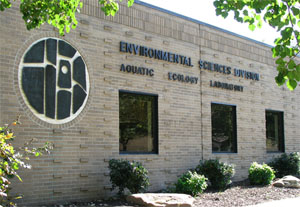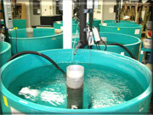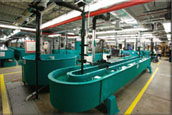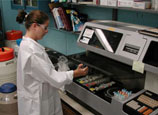Aquatic Ecology Laboratory

A Brief History
The Aquatic Ecology Laboratory was constructed in 1972 to support the DOE-funded Thermal Effects Research Program. With a national emphasis on the commercial development of nuclear energy, thermal pollution was a significant environmental concern. Because nuclear power plants require large volumes of cooling water, the resultant thermal discharge can adversely affect biota in a variety of habitats, ranging from coastal marine and estuarine environments to large rivers and reservoirs. Twenty 1.2-m diameter fiberglass tanks and a state-of-the-art computerized temperature control system, which occupied most of the 5000 sq ft of floor space, were used to determine the thermal tolerances of aquatic species, information that could be used as design criteria for power plant siting and operation. Another 5000 sq ft of research space was added in 1982 to support studies of the toxicity of synthetic fuels, a new alternative energy source. The Toxicology Laboratory was created at this time and four years later, artificial streams replaced many of the large fiberglass holding tanks.
Current Facilities
Today, the Aquatic Ecology Laboratory contains eight 22-m artificial streams that can used as a flow-through or recycling system. A unique capability of these streams is their use with radiotracers, such as P-32, to investigate the transport of nutrients through various compartments of a simple ecosystem (e.g., water, algae, snails). Past radiotracer experiments have also included studies of the effectiveness of biofilms in the uptake of selected heavy metals. In addition to the streams, numerous fiberglas tanks, ranging from circular 750-L holding tanks to 1.2-m long X 55-cm wide X 30-cm deep Living Streams R are used for experimental purposes. The experiments can be conducted using either spring water or dechlorinated process water at varying flow rates and temperatures. Current experiments include tests of the effects of turbulence on behavioral responses of fish and their susceptibility to increased rates of predation.
Other features of the Aquatic Ecology Laboratory include the Toxicology Laboratory, which is now dedicated to testing the toxicity of the effluents discharged from local DOE facilities and of the streams receiving those effluents. Another large room contains the Seafloor Process Simulator.





